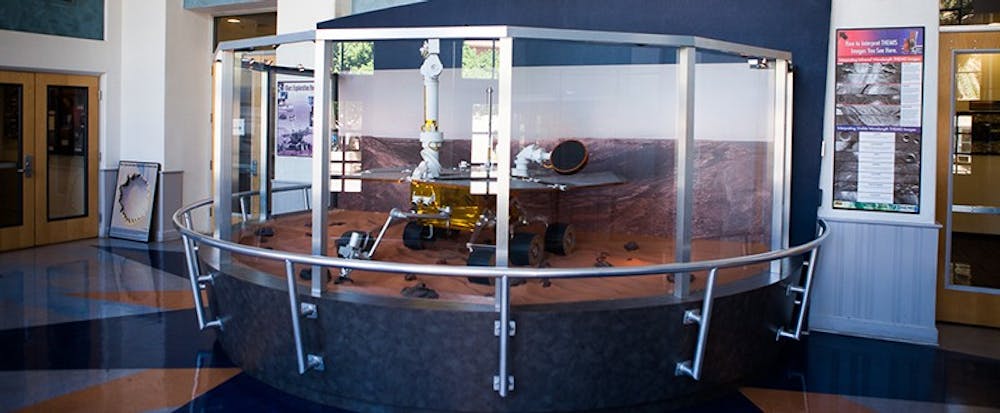 Athletic director Ray Anderson poses with students at a men's basketball game on Feb. 14. (Photo by Alexis Macklin)
Athletic director Ray Anderson poses with students at a men's basketball game on Feb. 14. (Photo by Alexis Macklin)For nearly eight years, Ray Anderson had been just a 15-minute walk away from work.
Although ASU’s new athletic director has moved from the NFL league offices in New York City to Tempe, Anderson still plans on hoofing it to the job.
Except he won’t be walking to a cushy Manhattan office — Anderson’s trek will take him to Sun Devil Stadium, Wells Fargo Arena, Packard Stadium and the Whiteman Tennis Center, among other ASU athletic facilities. And, of course, to his office overlooking Frank Kush Field.
“I want to be able to walk to every athletic venue and every point on campus,” Anderson said. “I think it’s important for an athletic director … (to) go to multiple events all weekend. (My wife and I) are going to take an apartment right here in Tempe, because I want to walk to work.”
Anderson thinks it’s crucial to make himself available and be involved in the community. He hopes to accomplish this by showing his face at a variety of ASU sporting events and either walking or biking from his nearby apartment around campus.
“I love waking; I love not driving,” Anderson said. “It just puts you in touch on a more regular basis with your community. … I think that will allow us to be more visible day and night.”
Anderson has already become a familiar face at ASU sporting events. He’s not just going and sitting in a suite, either. Anderson converses with any fan that recognizes him and wants to meet him.
Anderson’s friend and former colleague at the NFL, Merton Hanks, described him as a “people person.”
Hanks worked directly under Anderson at the NFL as vice president of football operations, and Anderson endorsed him as a replacement for the executive vice president position he vacated in February.
One of the major reasons that drew Anderson to ASU was the college environment and the amount of interaction available to him.
“I love people, and my relationships and passion in terms of interacting with people of all types and all ages,” Anderson said. “I just love interacting with folks and what better place to do it than on a college campus?”
In just three weeks on the job, Anderson has been to games ranging from men’s and women’s basketball to baseball to swim and dive, and he doesn’t plan on stopping anytime soon.
“The athletic director is supposed to be out and support the student athletes at their athletic events. I feel that’s part of my responsibility,” Anderson said. “More importantly, that stuff is fun. … I’m going to be out a lot. And I’m telling you, you’re going to see my wife as much as you’ll see me.”
 ASU athletic director Ray Anderson talks to students at the men's basketball game on Feb. 14 against UA. (Photo by Alexis Macklin)
ASU athletic director Ray Anderson talks to students at the men's basketball game on Feb. 14 against UA. (Photo by Alexis Macklin)Anderson’s wife, Buffie, has been snowed in in New York City, but has already managed to make it to an ASU women’s basketball game when she was in town for their introductory press conference.
Being as big of a sports fan as her husband, Buffie will be “Mrs. Athletic Director,” Anderson said.
“Our first event here was the women’s basketball game against USC, and it was like only three minutes into it, and she had all the names of all our women players on the roster,” he said. “She was calling them out by name, ‘Come on, Promise (Amukamara)!’ You’d think she was the mother of all of them.”
Women’s basketball may have been her first game, but the tennis courts will likely be Buffie’s stomping grounds. Anderson said she and tennis coach Sheila McInerney forged a quick bond when she was in town earlier.
“I love to play (tennis),” Buffie said. “I hope I will be able to get back into some tennis and cheer the girls on. I would love that.”
The Andersons have made a couple big moves in their lifetime, but Buffie said this one would be the hardest. She fell in love with the Northeast, but most of all, she was within walking distance of her children.
“Usually parents don’t get their kids back after college,” she said. “It was great for eight years to be able to walk over for lunch and see them on the weekends … Now they’ll just have to find another place to hang out.”
Despite that, Buffie said she is “all in” and excited for the move.
“There’s great things coming,” she said. “(Ray) has always been one to challenge himself. … This was something he wanted to do. He said he was in the fourth quarter, and he wants to make it count. … He got exactly what he really needed, and it’s a perfect fit for him.”
McInerney was excited about the hire of Anderson, especially after he began to show up at tennis matches.
“(Coming to athletic events) does make a difference, absolutely,” McInerney said. “Having (an athletic director) come out to your matches and getting to know the kids is important; it’s really what college athletics is about. I think Ray realizes (that).”
In his meeting with The State Press in December 2013, ASU President Dr. Michael Crow said ASU was looking for a “nontraditionalist” in its new athletic director.
“We're not interested in a traditional athletic director,” Crow said. “We're interested in academic success, athletic success, affinity success — that is connection to our students and connection to our community — and financial success.
 ASU gymnastics coach John Spini and junior Morgan Steigerwait talk with Anderson at a home meet on Feb. 15. (Photo by Arianna Grainey)
ASU gymnastics coach John Spini and junior Morgan Steigerwait talk with Anderson at a home meet on Feb. 15. (Photo by Arianna Grainey)“We're also not interested in someone that's just looking to jack up their salary or move up the chain or something where we're just this stepping stone to some other place.”
Anderson stressed that this isn’t a stepping stone for him. He said if it were about the money, he would have stayed at the NFL. Rather, this job is about personal gratification.
“Most folks who leave here are leaving to get those bigger jobs, or are leaving to get bigger paychecks and bigger compensation,” Anderson said. “I think the fact that I’ve done just the opposite — I’ve come here at a significant compensation reduction, because this is where I want to be.”
Anderson would be making $2.1 million at the league office — more if he had taken a president or CEO gig with a team — compared to $600,000 annually at ASU.
Hanks said Anderson has always wanted to be able to help young people – something he wasn’t able to do at the NFL.
“Probably the most important thing (for Anderson) was the opportunity to work with young people and affect their long-term livelihood,” Hanks said.
Hanks described Anderson as the “exact type of leader” ASU needs — someone who inspires people to be the best they can be and does it in an “honest, personable manner.”
“I think Arizona State got quite a coup in adding Ray Anderson as the VP of athletics,” Hanks said. “He is about being better; better today than you were yesterday. And he is about making sure you have a path to realize those dreams.”
While at the NFL, Anderson did a lot of public speaking. He frequently found himself at law firms, Kiwanis Clubs and corporate retreats alike. The one place that Anderson felt most at home? College campuses. Whether it was speaking to football teams, law or business schools or groups on campus, Anderson knew he wanted to be back on campus full-time one day.
“The times that I was most inspired, and I came away the most fired up was when I was in the academic environment,” Anderson said. “That’s why (I came to ASU), just coming back to college.”
Anderson’s first two stints in college were at two prestigious institutes. He received his bachelor’s in political science from Stanford University, then graduated from Harvard Law School three years later.
While Anderson conceded that it would be difficult to bring ASU to Stanford’s level academically, it’s something to which he aspires.
“We don’t have to be Stanford, but we can be like Stanford academically,” Anderson said. “One of the things that I’ve always admired about Stanford is the academics are very serious, very rigorous and the mixture of academics and athletics has gotten stronger … over the years.”
Something Anderson hopes to work alongside Crow with is raising academic standards for all students, including and especially student athletes.
“It’s going to take some time, but you’ve got to raise expectations,” Anderson said. “If you’re going to go to Arizona State and you’re going to play intercollegiate athletics, the expectations are you’re going to be a striving, committed student.”
Anderson said the reason he came to ASU — more so than anything else — was how well his vision lined up with Crow’s.
Much of the recruiting process, senior vice president of university affairs Jim O’Brien said, was selling Crow’s vision and goals for the University to Anderson.
“What we’re selling is not just trying to get (Anderson) to come here,” O’Brien said. “We’re trying to sell ASU as a vision, so that he comes here because he is attracted to the special nature, the unique nature of the institution.”
Even from afar, the message of the New American University is spreading. Hanks acknowledged the potential for growth the University has under the leadership of Anderson.
“I kidded with (Anderson) that it’s rather ironic, actually, that (ASU) has always been on my mind as one that could be a potential juggernaut,” Hanks said. “It just needs a little nudge here and there. … You need a person like Ray Anderson at the table to help you get there.”
Anderson said he has a “10-to-12 year vision” for ASU, and has no plans of leaving anytime soon.
“It’s going to take some time, so I want to see that through,” Anderson said. “I want to be able to pass the torch on to the next athletic director and have this place be one of the most coveted places a student-athlete or any student or any faculty member could land.”
Reach the reporter at ewebeck@asu.edu or follow him on Twitter @EvanWebeck




